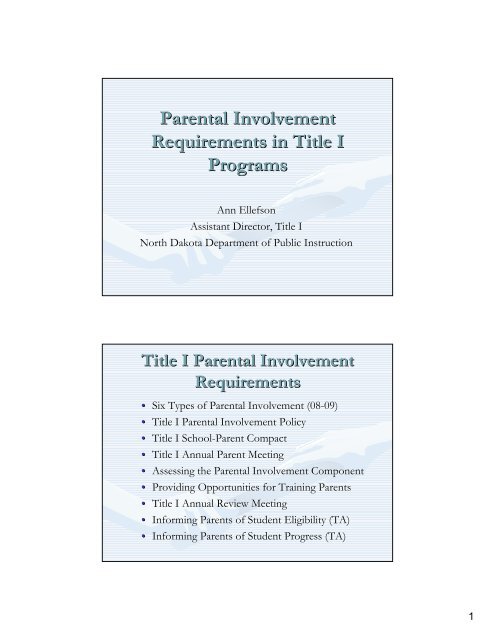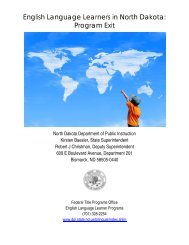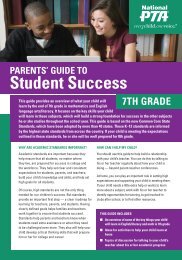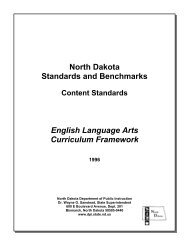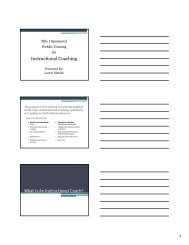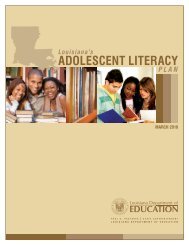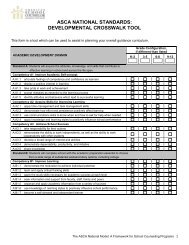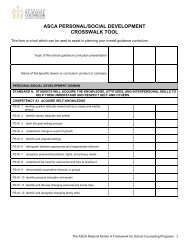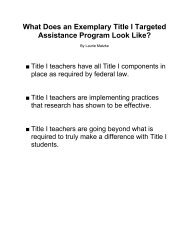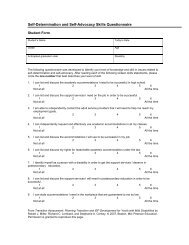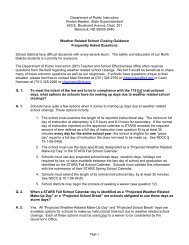Parental Involvement Requirements in Title I Programs Presentation
Parental Involvement Requirements in Title I Programs Presentation
Parental Involvement Requirements in Title I Programs Presentation
Create successful ePaper yourself
Turn your PDF publications into a flip-book with our unique Google optimized e-Paper software.
<strong>Parental</strong> <strong>Involvement</strong><br />
<strong>Requirements</strong> <strong>in</strong> <strong>Title</strong> I<br />
<strong>Programs</strong><br />
Ann Ellefson<br />
Assistant Director, <strong>Title</strong> I<br />
North Dakota Department of Public Instruction<br />
<strong>Title</strong> I <strong>Parental</strong> <strong>Involvement</strong><br />
<strong>Requirements</strong><br />
• Six Types of <strong>Parental</strong> <strong>Involvement</strong> (08-09)<br />
09)<br />
• <strong>Title</strong> I <strong>Parental</strong> <strong>Involvement</strong> Policy<br />
• <strong>Title</strong> I School-Parent Compact<br />
• <strong>Title</strong> I Annual Parent Meet<strong>in</strong>g<br />
• Assess<strong>in</strong>g the <strong>Parental</strong> <strong>Involvement</strong> Component<br />
• Provid<strong>in</strong>g Opportunities for Tra<strong>in</strong><strong>in</strong>g Parents<br />
• <strong>Title</strong> I Annual Review Meet<strong>in</strong>g<br />
• Inform<strong>in</strong>g Parents of Student Eligibility (TA)<br />
• Inform<strong>in</strong>g Parents of Student Progress (TA)<br />
1
Research shows that…<br />
No matter the socioeconomic status, when parents are<br />
<strong>in</strong>volved, students are more likely to …<br />
– Earn better grades<br />
– Obta<strong>in</strong> better test scores<br />
– Earn credits<br />
– Pass courses<br />
– Be promoted to the next<br />
grade<br />
– Attend school regularly<br />
– Have better social skills<br />
– Graduate<br />
– Cont<strong>in</strong>ue their education<br />
– Adapt to school<br />
A New Wave of Evidence: The Impact of School, Family, and Community Connections on Student<br />
Achievement (2002).<br />
Not only are the students<br />
impacted, but…<br />
• Parents become empowered<br />
• Teacher morale is improved<br />
• Student performance <strong>in</strong>creases<br />
• The community is<br />
strengthened<br />
2
Common Forms of <strong>Parental</strong><br />
<strong>Involvement</strong><br />
• Assist<strong>in</strong>g with homework<br />
• Classroom volunteers<br />
• Field trip chaperone<br />
• Member of the PTA<br />
• Letters sent home with students<br />
• Handbooks<br />
• Conferences<br />
“If a school uses the same old approach to <strong>in</strong>volve<br />
families and community, it will get the same old<br />
lackluster results.”<br />
Southwest Educational Development Laboratory (2000)<br />
3
Six Types of <strong>Parental</strong> <strong>Involvement</strong><br />
• Based on the work of Dr. Joyce Epste<strong>in</strong><br />
• Requirement for 2008-2009 2009 school year<br />
• Look at what you school is currently do<strong>in</strong>g<br />
– An Inventory of Present Practices of School, Family, and<br />
Community Partnerships handout<br />
Six Types of <strong>Parental</strong> <strong>Involvement</strong><br />
• Parent<strong>in</strong>g<br />
• Communicat<strong>in</strong>g<br />
• Learn<strong>in</strong>g at Home<br />
• Volunteer<strong>in</strong>g<br />
• Decision Mak<strong>in</strong>g<br />
• Collaborat<strong>in</strong>g with<br />
Community<br />
4
Six Types of <strong>Parental</strong> <strong>Involvement</strong><br />
Parent<strong>in</strong>g<br />
• Schools help families and caregivers understand the<br />
growth and development of their children.<br />
• Help with…<br />
– Parent<strong>in</strong>g and child-rear<strong>in</strong>g skills.<br />
– Understand<strong>in</strong>g child and adolescent development.<br />
– Establish<strong>in</strong>g age and grade appropriate home conditions that<br />
support children as students.<br />
• Families provide <strong>in</strong>formation to schools so educators<br />
and adm<strong>in</strong>istrators can better understand families’<br />
backgrounds, cultures, and goals for their children.<br />
Six Types of <strong>Parental</strong> <strong>Involvement</strong><br />
Parent<strong>in</strong>g – Sample Activities<br />
• Host<strong>in</strong>g family learn<strong>in</strong>g workshops on topics suggested<br />
by parents, held at times and places easily accessible to<br />
all parents, and provid<strong>in</strong>g childcare.<br />
• Provid<strong>in</strong>g families with <strong>in</strong>formation on child<br />
development.<br />
• Provid<strong>in</strong>g families with <strong>in</strong>formation about develop<strong>in</strong>g<br />
home conditions that support school learn<strong>in</strong>g.<br />
• Arrang<strong>in</strong>g support groups for families with special<br />
<strong>in</strong>terests and needs.<br />
• Provid<strong>in</strong>g guidance to parents on transition<strong>in</strong>g children<br />
to middle and high school.<br />
5
Six Types of <strong>Parental</strong> <strong>Involvement</strong><br />
Communicat<strong>in</strong>g<br />
• School-to<br />
to-home and home-to<br />
to-school communications<br />
about the district, school, and classroom programs as well<br />
as student progress.<br />
• Help with…<br />
– Understand<strong>in</strong>g between school and home.<br />
– Cooperation between school and home.<br />
– Show<strong>in</strong>g students that their parents and teachers are work<strong>in</strong>g<br />
together to help them succeed.<br />
• Encourages families to provide reactions, ideas, and<br />
preferences to the school as well as ask questions about<br />
student progress and the school’s programs.<br />
Six Types of <strong>Parental</strong> <strong>Involvement</strong><br />
Communicat<strong>in</strong>g – Sample Activities<br />
• Schedul<strong>in</strong>g parent-teacher<br />
teacher-student conferences to<br />
establish student learn<strong>in</strong>g goals for the year.<br />
• Staff members send<strong>in</strong>g home positive messages about<br />
students.<br />
• Staff members mak<strong>in</strong>g home visits.<br />
• Involv<strong>in</strong>g families <strong>in</strong> student award and recognition<br />
events.<br />
• Encourag<strong>in</strong>g and mak<strong>in</strong>g provisions for staff members<br />
to communicate with parents about their children’s<br />
progress several times each semester.<br />
6
Six Types of <strong>Parental</strong> <strong>Involvement</strong><br />
Learn<strong>in</strong>g at Home<br />
• Students are the primary participants <strong>in</strong> learn<strong>in</strong>g at<br />
home activities as their homework is essentially their<br />
responsibility. Families and parents can enhance the<br />
impact of learn<strong>in</strong>g at home through their <strong>in</strong>volvement.<br />
• Helps with…<br />
– Information and ideas about the academic work their<br />
children do <strong>in</strong> class.<br />
– Coord<strong>in</strong>at<strong>in</strong>g what is happ<strong>in</strong>g <strong>in</strong> the classroom and activities<br />
at home.<br />
– How to help their children with homework.<br />
– Communications with the teacher.<br />
Six Types of <strong>Parental</strong> <strong>Involvement</strong><br />
Learn<strong>in</strong>g at Home – Sample Activities<br />
• Hav<strong>in</strong>g specific goals and activities that keep parents<br />
<strong>in</strong>formed about and supportive of their children’s<br />
homework.<br />
• Offer<strong>in</strong>g learn<strong>in</strong>g activities and events for the whole family.<br />
• Invit<strong>in</strong>g parents to borrow resources from school libraries<br />
for themselves and their families.<br />
• Help<strong>in</strong>g parents understand student assessments, <strong>in</strong>clud<strong>in</strong>g<br />
report cards and test<strong>in</strong>g, and how to help students<br />
improve.<br />
• Includ<strong>in</strong>g parents and other community members <strong>in</strong><br />
develop<strong>in</strong>g children’s learn<strong>in</strong>g outside of school activities.<br />
7
Six Types of <strong>Parental</strong> <strong>Involvement</strong><br />
Volunteer<strong>in</strong>g<br />
• Families are enabled to share their time and talent to<br />
support the school, classrooms, teachers, students, and<br />
their children.<br />
• Volunteer<strong>in</strong>g does not have to take place with<strong>in</strong> the<br />
school or classroom walls.<br />
– Help<strong>in</strong>g <strong>in</strong> the library, computer room, family room,<br />
resource room, playground, or lunch room.<br />
– Assist<strong>in</strong>g with after school programs or field trips.<br />
– Attend<strong>in</strong>g student performances, extra curricular<br />
activities, assemblies, celebrations, and other events.<br />
• Volunteers tell students, faculty and the community<br />
that parents care about the school and its students.<br />
Six Types of <strong>Parental</strong> <strong>Involvement</strong><br />
Volunteer<strong>in</strong>g – Sample Activities<br />
• Gather<strong>in</strong>g <strong>in</strong>formation about the level and frequency of<br />
family and community members participation <strong>in</strong> school<br />
programs.<br />
• Offer<strong>in</strong>g youth service learn<strong>in</strong>g opportunities for<br />
students who want to volunteer <strong>in</strong> the community.<br />
• Assist<strong>in</strong>g school staff to learn how to work with parent<br />
and community volunteers.<br />
• Offer<strong>in</strong>g volunteer opportunities for s<strong>in</strong>gle parents.<br />
• Hav<strong>in</strong>g a program to recognize school volunteers.<br />
8
Six Types of <strong>Parental</strong> <strong>Involvement</strong><br />
Decision Mak<strong>in</strong>g<br />
• Parents’ voices must be heard when it comes to<br />
decision mak<strong>in</strong>g at the school.<br />
• Helps with…<br />
– Enabl<strong>in</strong>g families to participate <strong>in</strong> decisions about<br />
the school’s programs and activities that will impact<br />
their own and other children.<br />
– Involv<strong>in</strong>g all parents.<br />
• Hav<strong>in</strong>g families as true stakeholders <strong>in</strong> the<br />
school creates feel<strong>in</strong>gs of ownership of the<br />
school’s programs and activities.<br />
Six Types of <strong>Parental</strong> <strong>Involvement</strong><br />
Decision Mak<strong>in</strong>g – Sample Activities<br />
• Encourag<strong>in</strong>g parents to attend school improvement<br />
team meet<strong>in</strong>gs.<br />
• Assign<strong>in</strong>g staff members to help parents address<br />
concerns or compla<strong>in</strong>ts.<br />
• Invit<strong>in</strong>g staff and parent groups to meet collaboratively,<br />
provid<strong>in</strong>g space and time to do so.<br />
• Help<strong>in</strong>g families advocate for each other.<br />
• Involv<strong>in</strong>g parents <strong>in</strong><br />
– Plann<strong>in</strong>g orientation programs for new families<br />
– Develop<strong>in</strong>g parent<strong>in</strong>g skills programs<br />
– Hir<strong>in</strong>g staff members<br />
9
Six Types of <strong>Parental</strong> <strong>Involvement</strong><br />
Collaborat<strong>in</strong>g with Community<br />
• Communities have a significant role to play <strong>in</strong> the<br />
education, development, and well-be<strong>in</strong>g of students.<br />
• Helps with…<br />
– Encourag<strong>in</strong>g and support<strong>in</strong>g the cooperation between<br />
schools, families, community groups, organizations, agencies,<br />
and <strong>in</strong>dividuals.<br />
– Identify<strong>in</strong>g and <strong>in</strong>tegrat<strong>in</strong>g community resources (human,<br />
economic, material, or social) to improve schools, strengthen<br />
families, and assist students to succeed.<br />
Six Types of <strong>Parental</strong> <strong>Involvement</strong><br />
Collaborat<strong>in</strong>g with Community – Sample Activities<br />
• Act<strong>in</strong>g as a source of <strong>in</strong>formation and referral about<br />
services available for families <strong>in</strong> the community.<br />
• Encourag<strong>in</strong>g local civic and service groups to become<br />
<strong>in</strong>volved <strong>in</strong> schools <strong>in</strong> a variety of ways such as<br />
mentor<strong>in</strong>g students, volunteer<strong>in</strong>g, speak<strong>in</strong>g to classes,<br />
and help<strong>in</strong>g with fund-rais<strong>in</strong>g events.<br />
• Encourag<strong>in</strong>g staff and students to participate <strong>in</strong> youth<br />
service-learn<strong>in</strong>g opportunities.<br />
• Open<strong>in</strong>g school build<strong>in</strong>gs for use by the community<br />
beyond the regular school hours.<br />
• Hav<strong>in</strong>g a program with local bus<strong>in</strong>esses that enhances<br />
student work skills.<br />
10
<strong>Parental</strong> <strong>Involvement</strong> Policies<br />
Must have a written<br />
District <strong>Parental</strong> <strong>Involvement</strong> Policy<br />
AND<br />
A School <strong>Parental</strong> <strong>Involvement</strong> Policy<br />
• Must <strong>in</strong>clude all necessary <strong>in</strong>formation—<br />
Template<br />
• Plan to distribute the policies to parents each<br />
year<br />
• Update the policies each year<br />
School-Parent Compact<br />
• Must have a written<br />
school-parent compact<br />
• Must <strong>in</strong>clude all<br />
necessary<br />
<strong>in</strong>formation—Template<br />
• Plan to distribute the compact to parents<br />
every year<br />
• Update the compact each year<br />
11
Annual Parent Meet<strong>in</strong>g<br />
• Preferably, held <strong>in</strong> the beg<strong>in</strong>n<strong>in</strong>g of the<br />
school year<br />
• Describes<br />
– The <strong>Title</strong> I program<br />
– How the <strong>Title</strong> I students will be assessed<br />
– How the parents will be kept <strong>in</strong>formed<br />
– <strong>Parental</strong> <strong>in</strong>volvement opportunities<br />
• Document the meet<strong>in</strong>g with<br />
m<strong>in</strong>utes/agenda/sign-<strong>in</strong> sheets<br />
Annual Assessment of <strong>Parental</strong><br />
<strong>Involvement</strong><br />
• At the end of each school year<br />
• Gives parents an opportunity to voice how<br />
effective and realistic the parental <strong>in</strong>volvement<br />
plan was<br />
• Must be documented<br />
• Use the results of the assessment at the Annual<br />
Review Meet<strong>in</strong>g<br />
12
Assess<strong>in</strong>g the <strong>Parental</strong> <strong>Involvement</strong><br />
Component<br />
• Done at the end of the school year<br />
• Assesses the <strong>in</strong>volvement of parents <strong>in</strong> <strong>Title</strong> I<br />
and the <strong>Title</strong> I program<br />
• Documented—usually<br />
usually<br />
through a survey<br />
• Notify parents of assessment<br />
results<br />
Annual Review Meet<strong>in</strong>g<br />
• Preferably held at the end of the school<br />
year<br />
• Review<br />
– All the components of <strong>Title</strong> I<br />
– Parent assessment results<br />
– Input from the classroom teachers<br />
• Must be documented with<br />
m<strong>in</strong>utes or agenda<br />
13
Inform<strong>in</strong>g Parents of Student<br />
Eligibility (TA)<br />
• Done after the student selection process is<br />
completed<br />
• Written correspondence to parents<br />
• May or may not require the letters to be<br />
returned—depends depends on what your letter<br />
says<br />
• IF PARENT REFUSES, parent’s signature<br />
must be on file<br />
Inform<strong>in</strong>g Parents of Student<br />
Progress (TA)<br />
• Must use three different assessments per<br />
subject<br />
• Assessments may be objective or subjective<br />
• Placed <strong>in</strong> portfolio<br />
• Results must be shared with parents<br />
• Sent home at least two times a year,<br />
preferably more often<br />
14
The Importance of <strong>Parental</strong><br />
<strong>Involvement</strong><br />
“Studies show when parents and<br />
community members are engaged <strong>in</strong><br />
schools, students perform better,<br />
attendance <strong>in</strong>creases and dropout rates<br />
are lower.”<br />
Questions or Comments<br />
Ann Ellefson<br />
North Dakota Department of Public Instruction<br />
600 E Boulevard Ave., Dept. 201<br />
Bismarck, ND 58505-0440<br />
0440<br />
Phone – (701) 328-2292<br />
2292<br />
Fax – (701) 328-4770<br />
E-mail<br />
– aellefson@nd.gov<br />
15
Resources<br />
Epste<strong>in</strong>, J., Sanders, M., Simon, B., Sal<strong>in</strong>as, K., Jansorn, , N., and Voorhis, , F.<br />
(2002). School, Family, and Community Partnerships: Your Handbook for Action<br />
(2nd<br />
ed.). California: Corw<strong>in</strong> Press, Inc.<br />
National Network of Partnership Schools. (n.d(<br />
n.d.). .). Epste<strong>in</strong>’s Six Types of Parent<br />
<strong>Involvement</strong>. . Retrieved August 21, 2007 from<br />
www.csos.jhu.edu/p2000/sixtypes.htm.<br />
Southwest Educational Development Laboratory. (2000). Family and<br />
Community <strong>Involvement</strong>: Reach<strong>in</strong>g Out to Diverse Populations.<br />
The Benefits of Family-School Partnerships. (2005). Retrieved February 8, 2005<br />
from www.ncpie.org/AboutNCPIE/AboutPartnerships.html<br />
16


